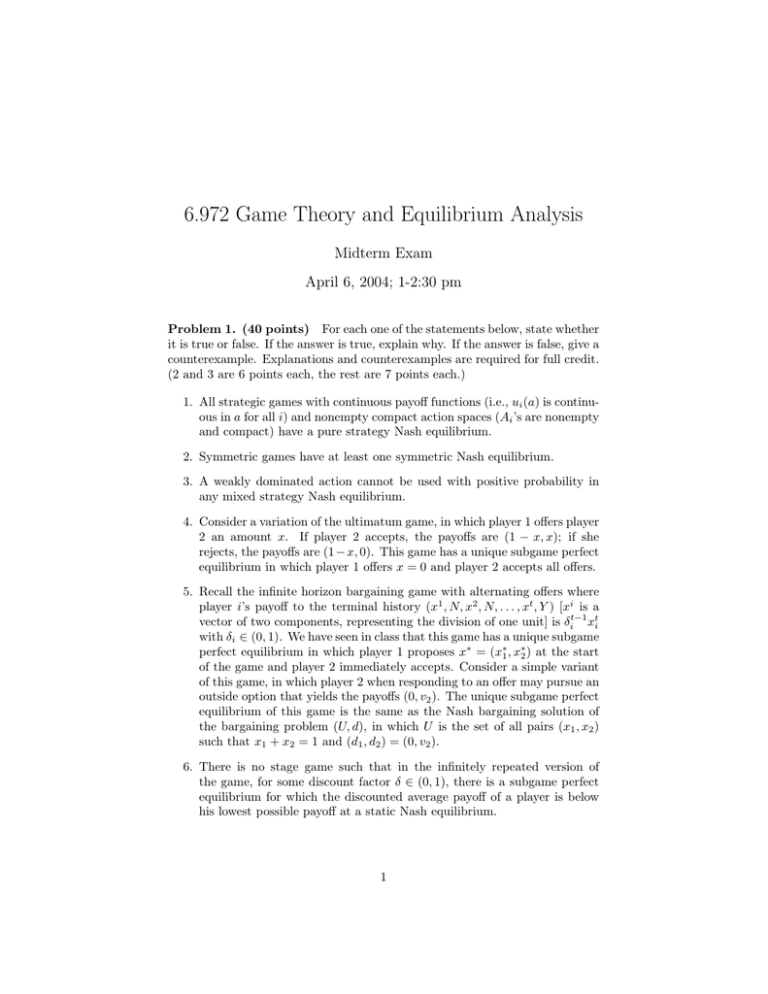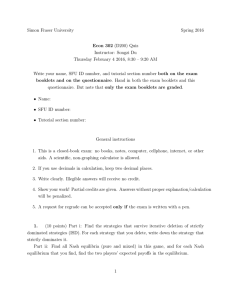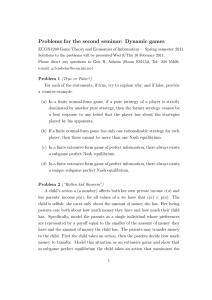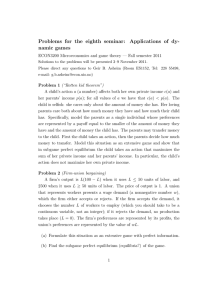6.972 Game Theory and Equilibrium ... Midterm Exam
advertisement

6.972 Game Theory and Equilibrium Analysis Midterm Exam April 6, 2004; 1-2:30 pm Problem 1. (40 points) For each one of the statements below, state whether it is true or false. If the answer is true, explain why. If the answer is false, give a counterexample. Explanations and counterexamples are required for full credit. (2 and 3 are 6 points each, the rest are 7 points each.) 1. All strategic games with continuous payoff functions (i.e., ui (a) is continu­ ous in a for all i) and nonempty compact action spaces (Ai ’s are nonempty and compact) have a pure strategy Nash equilibrium. 2. Symmetric games have at least one symmetric Nash equilibrium. 3. A weakly dominated action cannot be used with positive probability in any mixed strategy Nash equilibrium. 4. Consider a variation of the ultimatum game, in which player 1 offers player 2 an amount x. If player 2 accepts, the payoffs are (1 − x, x); if she rejects, the payoffs are (1 − x, 0). This game has a unique subgame perfect equilibrium in which player 1 offers x = 0 and player 2 accepts all offers. 5. Recall the infinite horizon bargaining game with alternating offers where player i’s payoff to the terminal history (x1 , N, x2 , N, . . . , xt , Y ) [xi is a vector of two components, representing the division of one unit] is δit−1 xti with δi ∈ (0, 1). We have seen in class that this game has a unique subgame perfect equilibrium in which player 1 proposes x∗ = (x∗1 , x∗2 ) at the start of the game and player 2 immediately accepts. Consider a simple variant of this game, in which player 2 when responding to an offer may pursue an outside option that yields the payoffs (0, v2 ). The unique subgame perfect equilibrium of this game is the same as the Nash bargaining solution of the bargaining problem (U, d), in which U is the set of all pairs (x1 , x2 ) such that x1 + x2 = 1 and (d1 , d2 ) = (0, v2 ). 6. There is no stage game such that in the infinitely repeated version of the game, for some discount factor δ ∈ (0, 1), there is a subgame perfect equilibrium for which the discounted average payoff of a player is below his lowest possible payoff at a static Nash equilibrium. 1 Problem 2. (30 points) P1 / P2 U M D U 4, 4 0, 0 5, 0 M 0, 0 3, 3 0, 0 Consider the following strategic form game: D 0, 5 0, 0 1, 1 1. How many pure strategies does each player have in this strategic game? Find all the Nash equilibria of the stage game (pure and mixed). Suppose this stage game is played twice. Players’ payoffs are given by discounted average of stage payoffs, with discount factor δ ∈ (0, 1). After the first round, all the actions are observed. 2. How many pure strategies does each player have in this finitely repeated game? 3. Show that if the discount factor, δ, in this game is close enough to 1, the following play (outcome path) can be supported as a subgame per­ fect equilibrium: [(U,U),(M,M)]. Find the corresponding strategies at this subgame perfect equilibrium. 4. Explain why twice repetition can ensure cooperation (i.e., play of Pareto efficient non-Nash equilibrium play in stage game) while this is not possible in finitely repeated prisoner’s dilemma. 5. Now consider the T-period repeated play of this stage game. What is the outcome path of the subgame perfect equilibrium that yields the highest discounted average payoff for both players (i.e., the ‘best SPE’)? Describe the outcome path of the best SPE as T→ ∞ and δ → 1. Contrast this with the limiting behavior of the T -period repeated prisoner’s dilemma. (Recall that T → ∞ and infinitely repeated game are different.) Problem 3. (War of Attrition) (30 points) PART I (10 points): In a war of attrition, two players compete for an object by expending resources over time (i.e., time is valuable). The value of the object to player i is vi > 0. Assume in this part that the values are known by both players. Each player chooses when to concede the object to the other player. The payoffs for the strategy profile (t1 , t2 ) are as follows: ⎧ ⎫ if ti < tj ⎬ ⎨ −ti if ti = tj vi /2 − ti ui (t1 , t2 ) = (1) ⎩ ⎭ vi − tj if ti > tj Formulate this situation as a strategic game and show that in all Nash equilibria, one of the players concedes immediately (i.e., t1 = 0 or t2 = 0). 2 PART II (20 points): Consider an incomplete-information version of the war of attrition of two players, in which the values are privately known. Player i chooses the time to concede ti ∈ [0, +∞) according to his/her strategy si (vi ) = ti , where vi is player i’s value of the object, which takes value in [0, +∞) with cumulative distribution function F and probability density function f . The val­ uations are independent between players. Both players choose simultaneously. The payoffs are ⎧ ⎫ if ti < tj ⎬ ⎨ −ti vi /2 − ti if ti = tj ui (t1 , t2 ) = (2) ⎩ ⎭ vi − tj if ti > tj 1. Characterize a symmetric Bayesian Nash equilibrium. (Assume that first order conditions are sufficient.) 2. Let F (v) = 1 − exp(−v) for v ≥ 0. Derive the symmetric Bayesian Nash equilibrium explicitly. 3. Relate the war of attrition with incomplete information to the auction forms that we have seen. Assume that there exists a symmetric equilibrium s(v), increasing in v, such that the expected payment of a bidder with value 0 is 0. Use the revenue equivalence theorem to derive a symmetric Bayesian Nash equilibrium. 3 MIT OpenCourseWare http://ocw.mit.edu 6.254 Game Theory with Engineering Applications Spring 2010 For information about citing these materials or our Terms of Use, visit: http://ocw.mit.edu/terms.









